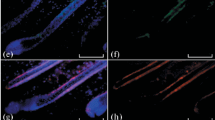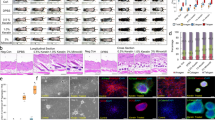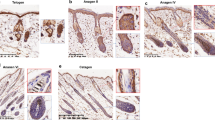Abstract
The anthracycline antibiotic daunomycin (DM) is useful for the treatment of leukemia but has side-effects such as alopecia. Using immunocytochemistry, we show that, after a single i.v. injection, DM accumulates in the nuclei of matrix cells and in the outer root sheath of hair follicles. DM-positive matrix cells are detectable up to 48 h after injection and exhibit a characteristic granular morphology, which is not observed in saline-injected controls. TUNEL-staining has revealed that DM injection induces programmed cell death (PCD) in rat hair follicles. Cells undergoing PCD are detectable as late as 5 days postinjection in both the matrix and outer root sheath. Newly developed double-staining has shown that some of the DM-positive matrix cell nuclei are also TUNEL-positive. Staining for activated caspase-3 has demonstrated immunopositive cells following DM administration both in the matrix and in the outer root sheath. Ultrastructural immunocytochemistry has shown the presence of DM-positive cells with two different types of morphology. About half of the immunopositive cells exhibit a morphology typical of classical apoptosis (PCD type 1), whereas the other half show signs of autophagic cell death (PCD type 2). Interestingly, little, if any, DM accumulation or apoptosis has been detected in the dermal hair papillae. This may have a bearing on potential regeneration of the hair follicles. Thus, DM accumulates in a characteristic pattern in hair follicles. This accumulation is associated with the induction of two morphologically distinct forms of PCD.





Similar content being viewed by others
Abbreviations
- BSA:
-
Bovine serum albumin
- CYP:
-
Cyclophosphamide
- DM:
-
Daunomycin
- DOX:
-
Doxorubicin (adriamycin)
- GA:
-
Glutaraldehyde
- HRP:
-
Horseradish peroxidase
- ICC:
-
Immunocytochemistry
- mAb:
-
Monoclonal antibody
- NGS:
-
Normal goat serum
- pAb:
-
Polyclonal antibody
- PBS:
-
Phosphate-buffered saline
- PCD:
-
Programmed cell death
- PFA:
-
Paraformaldehyde
- RT:
-
Room temperature
- TBS:
-
TRIS-buffered saline
- TBST:
-
TBS containing 1% Triton X-100
- TdT:
-
Terminal deoxynucleotidyl transferase
References
Adams JC (1981) Heavy metal intensification of DAB-based HRP reaction product. J Histochem Cytochem 29:775
Amoh Y, Li L, Katsuoka K, Hoffman RM (2007) Chemotherapy targets the hair-follicle vascular network but not the stem cells. J Invest Dermatol 127:11–15
Anilkumar TV, Sarraf CE, Hunt T, Alison MR (1992) The nature of cytotoxic drug-induced cell death in murine intestinal crypts. Br J Cancer 65:552–558
Blum RH, Carter SK (1974) Adriamycin. A new anticancer drug with significant clinical activity. Ann Intern Med 80:249–259
Bodó E, Tobin DJ, Kamenisch Y, Bíró T, Berneburg M, Funk W, Paus R (2007) Dissecting the impact of chemotherapy on the human hair follicle: a pragmatic in vitro assay for studying the pathogenesis and potential management of hair follicle dystrophy. Am J Pathol 171:1153–1167
Botchkarev VA, Komarova EA, Siebenhaar F, Botchkareva NV, Komarov PG, Maurer M, Gilchrest BA, Gudkov AV (2000) p53 is essential for chemotherapy-induced hair loss. Cancer Res 60:5002–5006
Bristow MR (1982) Toxic cardiomyopathy due to doxorubicin. Hosp Pract 18:291–300
Burke JF, Laucius JF, Brodovsky HS, Soriano RZ (1977) Doxorubicin hydrochloride-associated renal failure. Arch Intern Med 137:385–388
Bursch W, Ellinger A, Gerner C, Fröhwein U, Schulte-Hermann R (2000) Programmed cell death (PCD). Apoptosis, autophagic PCD, or others? Ann N Y Acad Sci 926:1–12
Cece R, Cazzaniga S, Morelli D, Sfondrini L, Bignotto M, Ménard S, Colnaghi MI, Balsari A (1996) Apoptosis of hair follicle cells during doxorubicin-induced alopecia in rats. Lab Invest 75:601–609
Chabner BA, Ryan DP, Paz-Ares L, Carbonero RG, Calabresi P (2001) Antineoplastic agents. In: Hardman JG, Limbird LE, Gilman AG (eds) Goodman and Gilman’s the pharmacological basis of therapeutics, 10th edn. McGraw-Hill, New York, p 1389
Cotsarelis G, Sun TT, Lavker RM (1990) Label-retaining cell residue in the bulge area of pilosebaceous unit: implications for follicular stem cells, hair cycle, and skin carcinogenesis. Cell 61:1329–1337
Damavandi E, Hishikawa Y, Izumi S, Shin M, Koji T (2002) Involvement of Bax redistribution in the induction of germ cell apoptosis in neonatal mouse testis. Acta Histochem Cytochem 35:449–459
Dean JC, Salmon SE, Griffith KS (1979) Prevention of doxorubicin-induced hair loss with scalp hypothermia. N Engl J Med 301:1427–1429
Dimarco A, Gaetani M, Dorigotti L, Soldati M, Bellini O (1963) Experimental studies of the antineoplastic activity of a new antibiotic daunomycin. Tumori 49:203–217
Egorin MJ, Hildebrand RC, Cimino EF, Bachur NR (1974) Cytofluorescence localization of adriamycin and daunorubicin. Cancer Res 34:2243–2245
Fujiwara K, Takatsu H, Tsukamoto K (2005) Immunocytochemistry for drugs containing an aliphatic amino group in the molecule, anticancer antibiotic daunomycin as a model. J Histochem Cytochem 53:467–474
Fujiwara K, Shin M, Hougaard MH, Larsson L-I (2007) Distribution of anticancer antibiotic daunomycin in the rat heart and kidney revealed by immunocytochemistry using monoclonal antibodies. Histochem Cell Biol 127:69–77
Gavrieli Y, Sherman Y, Ben-Sasson SA (1992) Identification of programmed cell death in situ via specific labeling of nuclear DNA fragmentation. J Cell Biol 119:493–501
Gille L, Nohl H (1997) Analyses of the molecular mechanism of adriamycin-induced cardiotoxicity. Free Radic Biol Med 23:775–782
Graham RC, Karnovsky MJ (1966) Glomerular permeability. Ultrastructural cytochemitry by a new technique. J Histochem Cytochem 14:291–302
Hendrix S, Handjiski B, Peters EM, Paus R (2005) A guide to assessing damage response pathways of the hair follicle: lessons from cyclophosphamide-induced alopecia in mice. J Invest Dermatol 125:42–51
Hoffman RM (2000) The hair follicle as a gene therapy target. Nat Biotechnol 18:20–21
Ijiri K, Potten CS (1987) Further studies on the response of intestinal crypt cells of different hierarchical status to eighteen different cytotoxic agents. Br J Cancer 55:113–123
Izumi S, Shin M, Hishikawa Y, Koji T (2001) Localization in situ of specific RNA by electron microscopy. Ital J Anat Embryol 106:45–50
Kligman AM (1959) The human hair cycle. J Invest Dermatol 33:307–316
Kondo Y, Kanzawa T, Sawaya R, Kondo S (2005) Role of autophagy in cancer development and response to therapy. Nat Rev Cancer 5:726–734
Lambert LA, Qiao N, Hunt KK, Lambert DH, Mills GB, Meijer L, Keyomarsi K (2008) Autophagy: a novel mechanism of synergistic cytotoxicity between doxorubicin and roscovitine in a sarcoma model. Cancer Res 68:7966–7974
Levine B, Yuan J (2005) Autophagy in cell death: an innocent convict? J Clin Invest 115:2679–2688
Lindner G, Botchkarev VA, Botchkareva NV, Ling G, Veen C van der, Paus R (1997) Analysis of apoptosis during hair follicle regression (catagen). Am J Pathol 151:1601–1617
Lu L, Wu W, Yan J, Li X, Yu H, Yu X (2008) Adriamycin-induced autophagic cardiomyocyte death plays a pathogenic role in a rat model of heart failure. Int J Cardiol 134:82–90
Ohara K, Shin M, Larsson L-I, Fujiwara K (2007a) Improved immunocytochemical detection of daunomycin. Histochem Cell Biol 127:603–608
Ohara K, Shin M, Larsson L-I, Fujiwara K (2007b) Immunocytochemical studies on the distribution pattern of daunomycin in rat gastrointestinal tract. Histochem Cell Biol 128:285–290
Oshima H, Rochat A, Kedzia C, Kobayashi K, Barrandon Y (2001) Morphogenesis and renewal of hair follicles from adult multipotent stem cells. Cell 104:233–245
Papageorgiou G, Iliadis S, Botsoglou N, Dioudis C, Goulas A, Fletouris D, Dimitriadou-Vafiadou A (1998) Lipid peroxidation of rat myocardial tissue following daunomycin administration. Toxicology 126:83–91
Paschoud N, Bignell C, Reinhold HS (1985) A double fluorescence method for detecting doxorubicin distribution and vascular supply in the mouse kidney. J Histochem Cytochem 33:73–76
Paus R, Rosenbach T, Haas N, Czarnetzki BM (1993) Pattern of cell death: the significance of apoptosis for dermatology. Exp Dermatol 2:3–11
Paus R, Handjiski B, Eichmüller S, Czarnetzki BM (1994) Chemotherapy-induced alopecia in mice. Induction by cyclophosphamide, inhibition by cyclosporine A, and modulation by dexamethasone. Am J Pathol 144:719–734
Pinkus H (1978) Epithelial-mesodermal interaction in normal growth, alpecia, and neoplasia. J Dermatol 5:93–101
Platel D, Bonorone-Adele S, Robert J (2001) Role of daunorubicinol in daunomycin-induced cardiotoxicity as evaluated with the model of isolated perfused rat heart. Pharmacol Toxicol 88:250–254
Rutherford A, Willingham MC (1993) Ultrastructural localization of daunomycin in multidrug-resistant culture cells with modulation of the multidrug transpoter. J Histochem Cytochem 41:1573–1577
Seifert CF, Nesser ME, Thompson DF (1994) Dexrazoxane in the prevention of doxorubicin-induced cardiotoxicity. Ann Pharmacother 28:1063–1072
Selleri S, Arnaboldi F, Vizzotto L, Barsari A, Rumio C (2004) Epithelium-mesenchyme compartment interaction and oncosis on chemotherapy-induced hair domage. Lab Invest 84:140
Sharov AA, Li GZ, Palkina TN, Sharova TY, Gilchrest BA, Botchkarev VA (2003) Fas and c-kit are involved in the control of hair follicle melanocyte apoptosis and migration in chemotherapy-induced hair loss. J Invest Dermatol 120:27–35
Sharov AA, Siebenhaar F, Sharova TY, Botchkareva NV, Gilchrest BA, Botchkarev VA (2004) Fas signaling is involved in the control of hair follicle response to chemotherapy. Cancer Res 64:6266–6270
Skladanowski A, Konopa J (1993) Adriamycin and daunomycin induce programmed cell death (apoptosis) in tumor cells. Biochem Pharmacol 46:375–382
Slominski A, Paus R, Plonka P, Handjiski B, Maurer M, Chakraborty A, Mihm MC Jr (1996) Pharmacological disruption of hair follicle pigmentation by cyclophosphamide as a model for studying the melanocyte response to and recovery from cytotoxic drug damage in situ. J Invest Dermatol 106:1203–1211
Takahashi S, Bachur NR (1975) Daunorubicin metabolites in human urine. J Pharmacol Exp Ther 195:41–49
Taylor G, Lehrer MS, Jensen PJ, Sun TT, Lavker RM (2000) Involvment of follicular stem cells in forming not only the follicle but also the epidermis. Cell 102:451–461
Thakkar NS, Potten CS (1992) Abrogation of adriamycin toxicity in vivo by cycloheximide. Biochem Pharmacol 43:1683–1691
Thakkar NS, Potten CS (1993) Inhibition of doxorubicin-induced apoptosis in vivo by 2-deoxy-D-glucose. Cancer Res 53:2057–2060
Tobin DJ, Hagen E, Botchkarev VA, Paus R (1998) Do hair bulb melanocytes undergo apoptosis during hair follicle regression (catagen)? J Invest Dermatol 111:941–947
Tobin DJ, Gunin A, Magerl M, Paus R (2003) Plasticity and cytokinetic dynamics of the hair follicle mesenchyme during the hair growth cycle: implications for growth and hair follicle transformations. J Invest Dermatol Symp Proc 8:80–86
Van Scoot EJ, Ekel TM (1958) Geometric relationships between the matrix of the hair bulb and its dermal papilla in normal and alopecia scalp. J Invest Dermatol 31:281–287
Willingham MC, Cornwell MM, Cardarelli CO, Gottesman MM, Pastan I (1986) Single cell analysis of daunomycin uptake and efflux in multidrug-resistant and sensitive KB cells: effects of verapamil and other drugs. Cancer Res 46:5941–5946
Yokoyama T, Miyazawa K, Naito M, Toyotake J, Tauchi T, Itoh M, You A, Hayashi Y, Georgescu M-M, Kondo Y, Kondo S, Ohyashiki K (2008) Vitamin K12 induces autophagy and apoptosis simultaneously in leukemia cells. Autophagy 4:629–640
Yousefi S, Perozzo R, Schmid I, Ziemiecki A, Schaffner T, Scapozza L, Brunner T, Simon HU (2006) Calpain-mediated cleavage of Atg5 switches autophagy to apoptosis. Nat Cell Biol 8:1124–1132
Zagotto G, Gatto B, Moro S, Sissi C, Palumbo M (2001) Anthracyclines: recent developments in their separation and quantification. J Chromatogr B Biomed Sci Appl 764:161–171
Zhang J, Clark JR, Herman EH, Ferrans VJ (1996) Doxorubicin-induced apoptosis in spontaneously hypertensive rats: differential effects in heart, kidney and intestine, and inhibition by ICRF-187. J Mol Cell Cardiol 28:1931–1943
Acknowledgment
We are grateful to K. Ohara, Y. Tamamura and K. Tanaka for their technical assistance throughout this study.
Author information
Authors and Affiliations
Corresponding author
Rights and permissions
About this article
Cite this article
Shin, M., Larsson, LI., Hougaard, D.M. et al. Daunomycin accumulation and induction of programmed cell death in rat hair follicles. Cell Tissue Res 337, 429–438 (2009). https://doi.org/10.1007/s00441-009-0840-8
Received:
Accepted:
Published:
Issue Date:
DOI: https://doi.org/10.1007/s00441-009-0840-8




